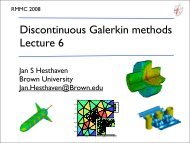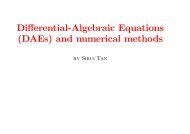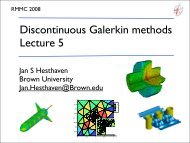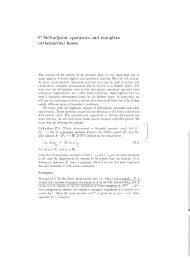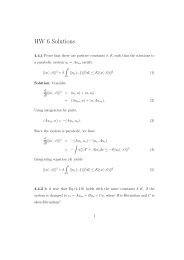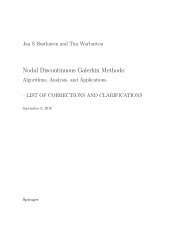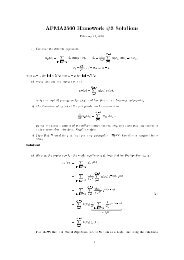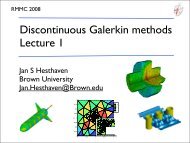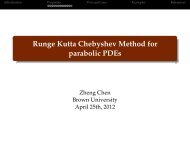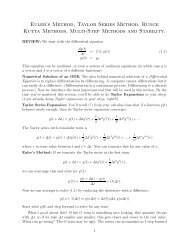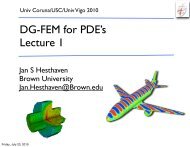MULTI-ELEMENT GENERALIZED POLYNOMIAL CHAOS FOR ...
MULTI-ELEMENT GENERALIZED POLYNOMIAL CHAOS FOR ...
MULTI-ELEMENT GENERALIZED POLYNOMIAL CHAOS FOR ...
Create successful ePaper yourself
Turn your PDF publications into a flip-book with our unique Google optimized e-Paper software.
908 XIAOLIANG WAN AND GEORGE EM KARNIADAKIS<br />
can use any numerical integration formula to calculate the table E[πlπmπn]. Here we<br />
consider the quadrature rule. We know that for the measure m(τ) there exists, for<br />
each M ∈ N, a quadrature rule<br />
�<br />
M�<br />
(2.25)<br />
f(τ)dσ(τ) = wif(τi)+RM (f),<br />
B<br />
i=1<br />
where RM (f) =0iff is a polynomial of degree ≤ 2M −c. The value of c is determined<br />
by the type of quadrature used, which can be either classical Gauss (c = 1), Gauss–<br />
Radau (c = 2), or Gauss–Lobatto (c = 3). If we do not consider the numerical<br />
accuracy of the recurrence coefficients, we need<br />
� �<br />
3p + c<br />
(2.26)<br />
M =<br />
2<br />
quadrature points to get the three-term integration E[πlπmπn] with zero error, where<br />
⌈∗⌉ denotes the smallest integer no less than ∗. Thus, we need to compute all the<br />
recurrence coefficients αi and βi with i ≤ M − 1 although we employ polynomials<br />
only up to order p.<br />
2.2.3. An adaptive procedure. Adaptivity is necessary for many cases, such<br />
as problems related to long-term integration or discontinuity. In this work we present a<br />
heuristic adaptivity criterion based on the relative local errors similar to the adaptivity<br />
criteria employed in the spectral element method for deterministic problems [22, 15].<br />
We assume that the gPC expansion of a random field in element k is<br />
(2.27)<br />
Np �<br />
ûk(ξk)= j=0<br />
ûk,jΦk,j(ξ k),<br />
where p is the highest order of PC and Np denotes the total number of basis modes<br />
given by<br />
(p + d)!<br />
Np = − 1,<br />
p!d! (2.28)<br />
where d is the dimension of ξk. From the orthogonality of gPC we can easily obtain<br />
the local variance given by PC with order p:<br />
(2.29)<br />
σ 2 k,p =<br />
�<br />
Np<br />
û 2 k,jE[Φ 2 k,j].<br />
The approximate global mean ū and variance ¯σ 2 can be expressed as<br />
(2.30)<br />
k=1<br />
j=1<br />
N�<br />
ū = ûk,0 Pr(IBk =1), ¯σ2 N�<br />
=<br />
k=1<br />
�<br />
σ 2 k,p +(ûk,0 − ū) 2�<br />
Pr(IBk =1).<br />
Compared to the error of variance, the error of mean is usually much smaller in the<br />
gPC method. Thus, we can express the exact global variance as<br />
(2.31)<br />
σ 2 ≈ ¯σ 2 +<br />
N�<br />
γk Pr(IBk =1),<br />
k=1



